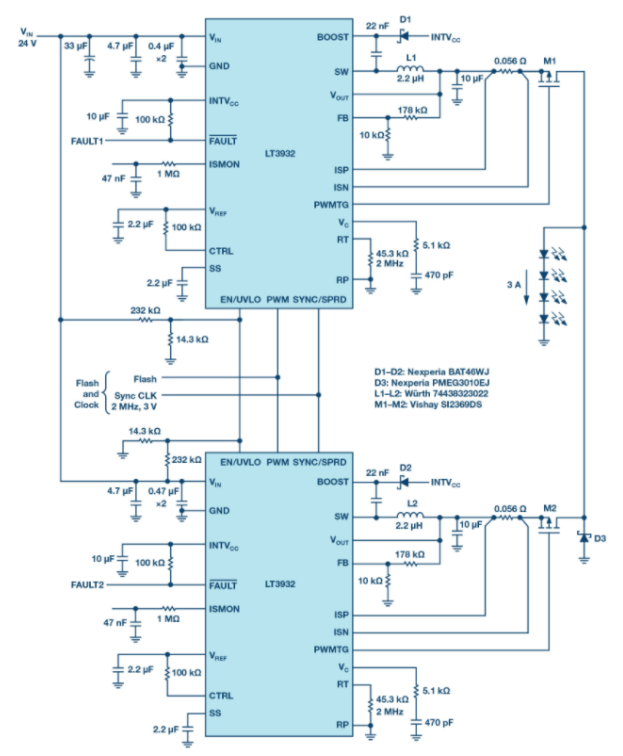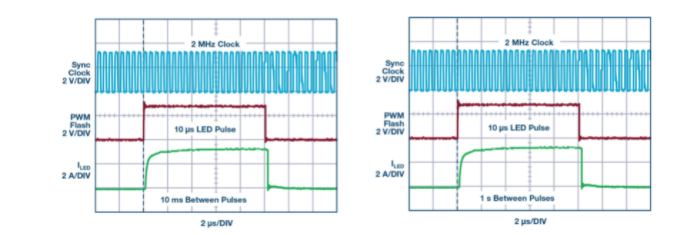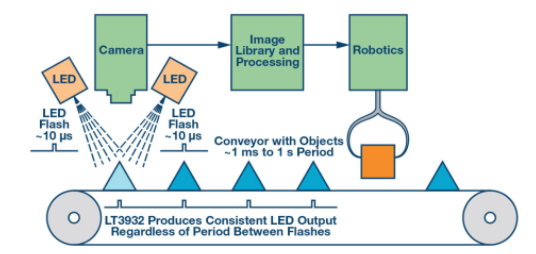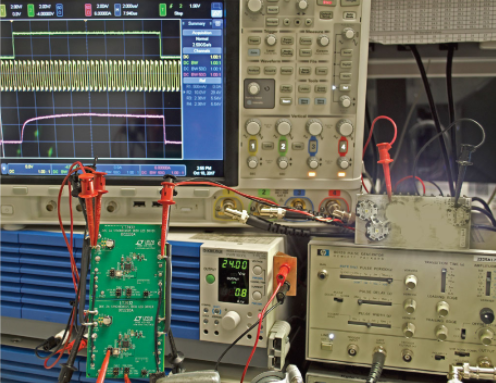July 08, 2021
2881
Machine vision systems use very short glare flashes to produce high-speed images for various data processing applications. For example, fast-moving conveyor belts use machine vision systems for rapid labeling and defect detection. Infrared and laser LED flashes are commonly used in machine vision for short-range and motion detection. The security system emits high-speed, imperceptible LED flashes to detect movement, capture and store security images.
A challenge that all these systems have is to generate very high current and short-term (microsecond) LED camera flash waveforms, which may spread out over a long period of time, such as 100 ms to more than 1 s. It is not easy to generate short-term LED flash square waves with longer intervals. When the driving current of the LED (or LED string) rises above 1 A, and the LED turn-on time is shortened to a few microseconds, the challenge is further increased. Many LED drivers with high-speed PWM capabilities may not be able to effectively handle long off-time and short-time high currents without degrading the quality of the square wave required to properly process high-speed images.
Proprietary LED flash
Fortunately, the LT3932 high-speed LED driver can provide machine vision camera flashes for LED strings up to 2 A, and the off time can be as long as 1 second, 1 hour, 1 day or more. The special camera flash function of the LT3932 allows it to keep the output capacitor and control loop charged, even during long off-time. After sampling the state of the output and control loop capacitors, the LT3932 continues to trickle charge these components during the long off period to compensate for the usual leakage current, which is not considered by other LED drivers.
The proprietary flashing technology of LT3932 can be expanded, and the drivers can be connected in parallel to provide higher LED flash current. The required flash shape and integrity remain unchanged. Figure 1 shows how easy it is to connect two drivers in parallel to support 3 A camera flashes, and designs up to 4 A are also possible.
The LED flashlight requirements for machine vision systems are far higher than those achieved by standard PWM dimming drivers. In other words, most high-end LED drivers are designed to provide PWM dimming brightness control at a PWM frequency of at least 100 Hz. This is because if the frequency is low, even if the LED waveform is square and repeatable, the human eye will see annoying flicker or strobe. At 100 Hz, the theoretical maximum turn-off time is approximately 10 ms. During the 10 ms turn-off time, if the design is correct, the LED driver will lose very little output capacitor charge, causing it to start the control loop in approximately the same state, thus ending the last PWM turn-on pulse. The fast response and ramp-up of the inductor current and the next LED PWM turn-on pulse can be fast and repeatable, and the startup time is extremely short. A long turn-off time (when the frequency is lower than 100 Hz) may cause the output capacitor to lose charge due to leakage, which will make the LED unable to respond quickly when it is turned on again.
Parallel LED drivers to provide higher current
The LED driver acts as a current source, regulating the current emitted by the light-emitting diode. The current only flows to the output in a single direction, so multiple LED drivers can be connected in parallel, and the currents will pass through the load after being aggregated. The current source does not need to guard against the reverse flow of current through a converter, nor does it need to worry about output mismatch. On the other hand, the voltage regulator itself is not good at current sharing. If they all try to adjust the output voltage to a certain point, and there are slight differences in their feedback networks, the regulator may absorb reverse current.
The LED driver will keep its output current constant, regardless of whether other drivers provide additional current and sum it up on the output load. This makes paralleling LED drivers very simple. For example, the LED flashlight system composed of two parallel LT3932 LED drivers shown in Figure 1 can drive 4 LEDs at a high efficiency of 3 A, and the short pulses of 10μs are scattered over a longer period defined by the machine vision system. During the PWM on time, each LT3932 converter generates half of the total string current; during the PWM off time, the converter shuts down and saves its output state. The turn-off time can be short or long, and has no effect on the repeatability of the flash waveform.

Figure 1. Relative to the standard PWM dimming frequency, a parallel LT3932 1.5 A LED driver generates a 3 A machine vision LED pulse with a long off time.

Figure 2. Regardless of the PWM off time, the 3 A camera flash waveforms with parallel LED drivers shown in Figure 1 look the same. The waveform shows that (a) 10 ms after 10 ms and (b) 10 μs pulse after 1 s are the same. After a day or longer PWM off time, the LT3932 LED flash waveform looks the same.
During long shutdown periods, parallel camera flash application is almost as simple as a single converter. The converter observes the shared output voltage at the end of the last PWM on-pulse, and allows the output capacitor to be charged to this state and maintained, even during the long off-time. Each converter disconnects its PWM MOSFET from the shared load, and supplies current to its output capacitor to compensate for the leaked energy, so that the capacitor is charged to near the final voltage state and maintained. Any leakage of these capacitors during the long off time can be compensated by a small amount of holding current. When the next PWM turn-on pulse begins, the PWM MOSFET of each converter turns on, and the output capacitor starts in roughly the same state as the last pulse, whether it's after 10 ms or a whole day.
Figures 2(a) and 2(b) show that the LT3932 parallel LED driver drives 4 LEDs at 3 A, and the machine vision camera pulse is 10 μs. Whether it is 10 ms PWM off time (100 Hz) or 1 s PWM off time (1 Hz), the LED pulses are steep and fast, which is ideal for machine vision systems.
Achieving higher current is also possible
Parallel LED drivers are not limited to two converters. Three or more converters can also be connected in parallel to produce higher current waveforms with steep edges. The system has no master or slave devices, so all converters provide the same amount of current and share the load equally. It is recommended that all parallel LED driver converters share the same synchronous clock and remain in phase. This ensures that the output capacitor ripples of all converters have roughly the same phase, so the ripple current does not flow in the reverse direction or between different converters. It is important that the PWM pulse waveform is in phase with the 2 MHz synchronization clock. This ensures that the LED flash waveform remains square and free of jitter, resulting in the best image processing results.
The LT3932 demonstration circuit (DC2286A) is designed to drive 1 A of LED current through one or two LEDs (as a step-down LED driver). As shown in Figure 1, it is easy to modify and parallel to achieve higher current, higher voltage or parallel operation. Figure 4 shows how to easily connect two such circuits to drive 4 LEDs with a 10μs, 3 A pulse from a 24 V input. For testing purposes, the pulse generator can be used to provide a synchronized clock signal, as shown in Figure 4. In mass production machine vision systems, clock chips can be used to generate synchronous clock signals and PWM pulses. For higher current pulses, you can use the same parallel scheme to add more demonstration circuit DC2286A converters.

Figure 3. An example of machine vision on an industrial conveyor belt. The detection system moves at many different speeds, but the flash technology must be fast and clear.

Figure 4. Two DC2286A LT3932 demonstration circuits can be easily connected in parallel to create the 3 A to 4 A machine vision LED flash application shown in Figure 1.
Concluding
Machine vision systems can use parallel LED drivers to create the fast, square, high-current waveforms required for automatic image processing. By paralleling converters, the proprietary camera flash technology of the LT3932 LED driver can be extended to higher currents. Using parallel LT3932 converters, even if the turn-off time is longer, microsecond pulses of 3 A and higher can be achieved. No matter how long the turn-off time between LED flashes is, the LED camera flash waveform can remain square and free of jitter.